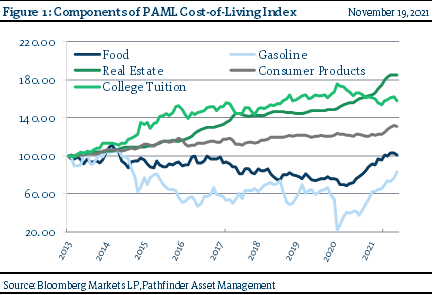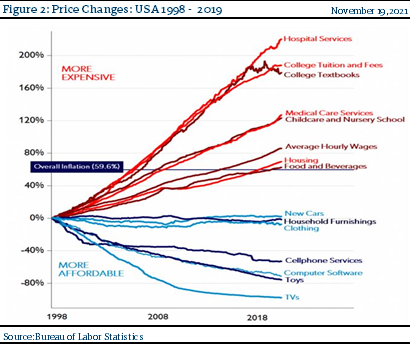Decomposing Inflation
Inflation has dominated headlines this year as the Consumer Price Index rises at a pace not seen in decades. Inflation is often talked about in whole (like the CPI) but decomposing inflation into individual items can give us better insight into where and why inflation is occurring. In fact, we have noticed a potential reversal in what is inflating and deflating.
- As can be seen in Figure 1 and Figure 2, the last 10-20 years has been marked by a lack of inflation and even deflation in consumer products, energy, and food. This deflation worried central bankers, who responded by structurally lowering interest rates to stoke inflation. As can also be seen, this stoked inflation but only in specific items: education and real estate. Not surprisingly, these are the items we typically borrow money to buy (student loans and mortgages), where interest rates really matter.

- Also seen in Figure 1, the last 12 months has seen a reversal in inflation for consumer products, energy, and food. This is worrying central bankers, who are talking of raising interest rates to cool this inflation. However, if we are to learn from the last 20 years, this could stoke deflation in the items we borrow money to buy, where interest rates really matter: education and real estate. In 2021, tuition for a private American university inflated at its slowest pace since the data has been tracked (1971).

Please refer to prior investment outlooks (our inflation series) for our opinion on why recent inflation is occurring and to why or why not this may be structural.
“This means that” if recent inflation trends are structurally (that’s a big if) it’s possible that significant inflation in consumer products, energy, and food result in much higher interest rates. In turn, this could drive deflation in components we borrow money to own: education and real estate. Basically, a potential reversal of the last 20 years.
National Instrument 31-103 requires registered firms to disclose information that a reasonable investor would expect to know, including any material conflicts with the firm or its representatives. Doug Johnson and/or Pathfinder Asset Management Limited are an insider of companies periodically mentioned in this report. Please visit www.paml.ca for full disclosures.
*All returns are time weighted and net of investment management fees. Returns from the Pathfinder Partners’ Fund and Partners’ Real Return Plus Fund are presented based on the masters series of each fund. The Pathfinder Core: Equity Portfolio and The Pathfinder Core: High Income Portfolio are live accounts. These are actual accounts owned by the Pathfinder Chairman (Equity) and client (High Income) which contain no legacy positions, cash flows or other Pathfinder investment mandates or products. Monthly inception dates for each fund and portfolio are as follows: Pathfinder Core: Equity Portfolio (January 2011), Pathfinder Core: High Income Portfolio (October 2012) Partners’ Fund (April 2011), Partners’ Real Return Plus Fund (April, 2013), and Partners’ Core Plus Fund (November 2014).
Pathfinder Asset Management Limited (PAML) and its affiliates may collectively beneficially own in excess of 10% of one or more classes of the issued and outstanding equity securities mentioned in this newsletter. This publication is intended only to convey information. It is not to be construed as an investment guide or as an offer or solicitation of an offer to buy or sell any of the securities mentioned in it. The author has taken all usual and reasonable precautions to determine that the information contained in this publication has been obtained from sources believed to be reliable and that the procedures used to summarize and analyze such information are based on approved practices and principles in the investment industry. However, the market forces underlying investment value are subject to sudden and dramatic changes and data availability varies from one moment to the next. Consequently, neither the author nor PAML can make any warranty as to the accuracy or completeness of information, analysis or views contained in this publication or their usefulness or suitability in any particular circumstance. You should not undertake any investment or portfolio assessment or other transaction on the basis of this publication, but should first consult your portfolio manager, who can assess all relevant particulars of any proposed investment or transaction. PAML and the author accept no liability of any kind whatsoever or any damages or losses incurred by you as a result of reliance upon or use of this publication.